
Tomography of Lunar Spherules
Overview
Downloads
Home page
Overview
Synchrotron x-ray micro-tomography is a technique that
provides non-destructive 3-dimensional information about rare samples on scales
from 1 to 17 microns/pixel.
This technique is particularly well-suited to rare, easily-damaged samples. Here, we report on
preliminary investigation of orange glass spherules returned by the
Apollo 17
astronauts from the lunar surface in 1971, along with other
samples.
In 1971, Apollo 17 astronauts collected a 10 cm soil sample (74220)
comprised almost entirely of orange glass spherules. Below this, a double drive-tube
core sampled a 68 cm thick horizon comprised of orange glass and black beads
(crystallized equivalents of orange glass). Primitive lunar glass spherules
(e.g.-A17 orange glasses) are thought to represent ejecta from lunar mare fire fountains [1, 2].
The fire-fountains were apparently driven by a combination of C-O gas exsolution
from orange glass melt and the oxidation of graphite [3, 4]. Upon eruption, magmas
lost their volatiles (e.g., S, CO, CO2) to space. Evidence for volatile escape
remains as volatile-rich coatings on the exteriors of many spherules [e.g., 5,6].
Moreover, [7] showed that Type I and II Fe-Ni-rich metal particles found within
orange glass olivine phenocrysts, or free-floating in the glass itself, are
powerful evidence for the volatile driving force for lunar fire fountains.
More direct evidence for the volatile mechanism has yet to be uncovered. Issues
remaining include: the exact composition of magmatic volatiles; the hypothe-sized
existence of graphite in the magma; the oxygen fugacity of the magma and of the
lunar interior.
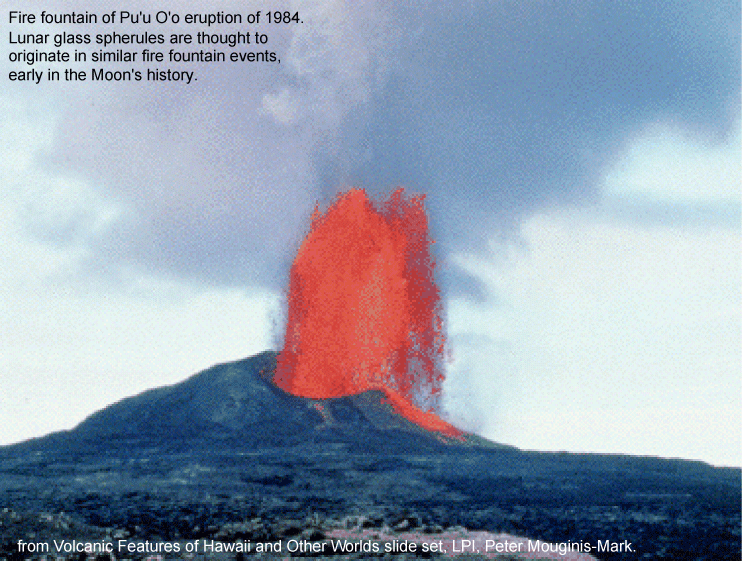
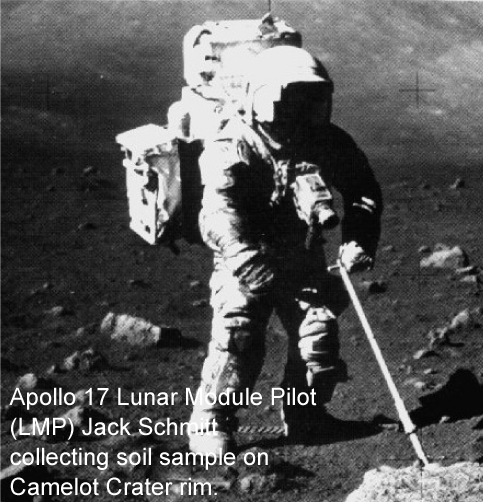
In 1996 [8] reported a single ~450 micron, equant olivine phenocryst, containing
four glassy melt inclusions (or inclusion cores), the largest ~30micron in size,
in a thin section of the 74001/2 drill core. The melt is assumed to sample the parent
magma of the lunar basalts at depth, evidenced by the S content of the inclusion
(600 ppm) which is 400 ppm greater than that of the orange glass host [8]. Such melts
potentially contain a full complement of the volatile components of the parent magma,
which can be analyzed by infrared (ir) spectroscopy. Although the A17 orange glass magma
is thought to derive from ~ 400 km depth [9], the calculations of [7] imply a 4 km
depth of graphite oxidation (and melt saturation in C-O volatiles) during ascent.
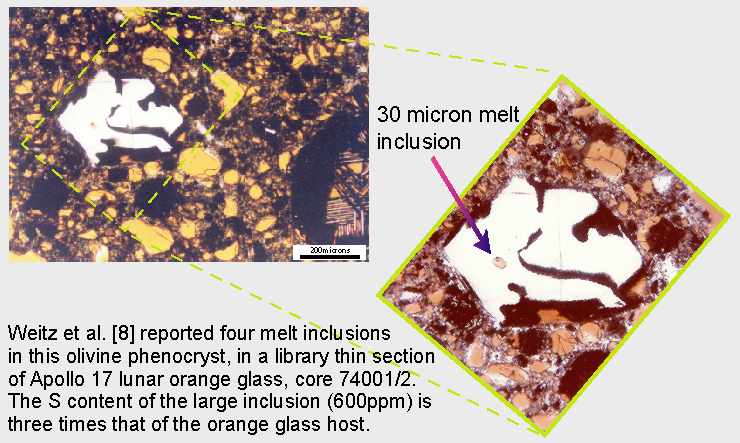
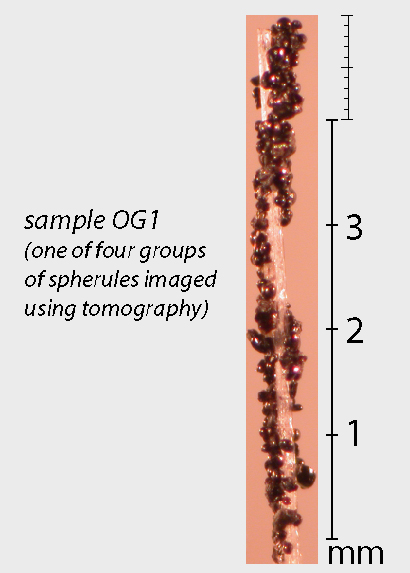
AMNH Research Scientist Bobby Fogel and I have imaged several hundred similar
orange glass spherules, from sample 74220,764, using synchrotron x-ray computer-aided
microtomography (XR-CMT).
Our goals:
1) locate similar phenocrysts containing melt inclusions;
2) analyze phenocrysts to understand the evolution of the magma;
3) analyze melt and fluid inclusions using EPMA and FTIR to obtain direct evidence
of magmatic volatiles and pristine bulk compositions.
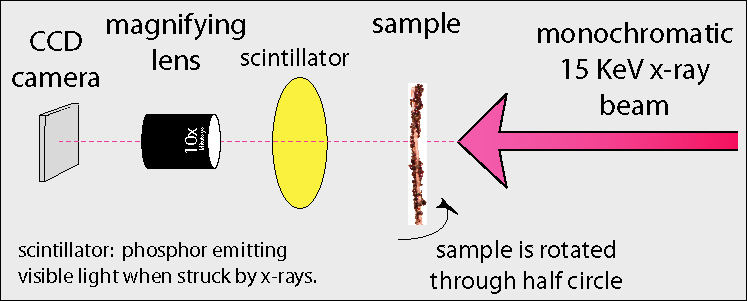
Technique: Loose spherules were placed in a crease of cellophane paper, and
picked up on four 0.2 x 1 x 60 mm plastic strips coated with ambroid, a model
airplane glue that dissolves completely in ethyl acetate.
Strips were imaged at beamline 13M (GSECARS) of the synchrotron at the Advanced
Photon Source (DOE). Density structures (arrays of cubic volume elements, or voxels)
at 16-bit density resolution were computed from images collected using 15 KeV x-rays,
a Pentamax SL 20x lens (37.5mm tube), for spatial resolution of 1.96 micron/pixel.
We then produced stacks of parallel image 'slices', resembling back-scattered electron
images in 256 gray scales chosen to enhance contrast (Figure). In tomographic images,
the darker pixels have lower x-ray attenuation than bright pixels.
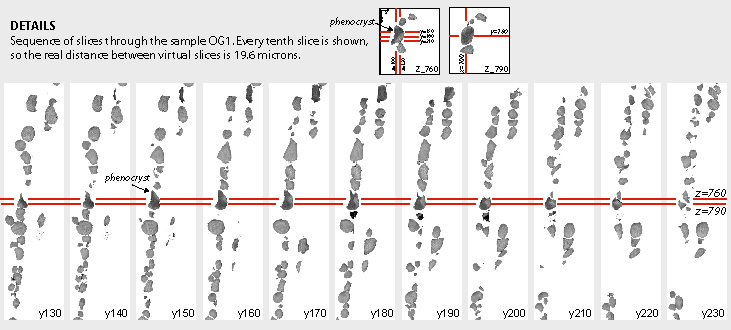
Images contain predictable noise and x-ray shadowing due to a variety of instrumental
factors and the Fourier transform reconstruction technique. Circular 'ripples'
perpendicular to the z axis probably result from a complex interaction of the ray
path with higher energy x-rays passed by the Si[220] monochromator [10]. Surface
effects (e.g., along the plastic substrate, Fig. 1a) appear as bright lines at
this pixel resolution, due to reflection when incident x-rays are at very small
angles to these surfaces. Some internal features of spherules that are not
phenocrysts are fine microcrystals formed when the spherules were quenched from liquid
to glass.
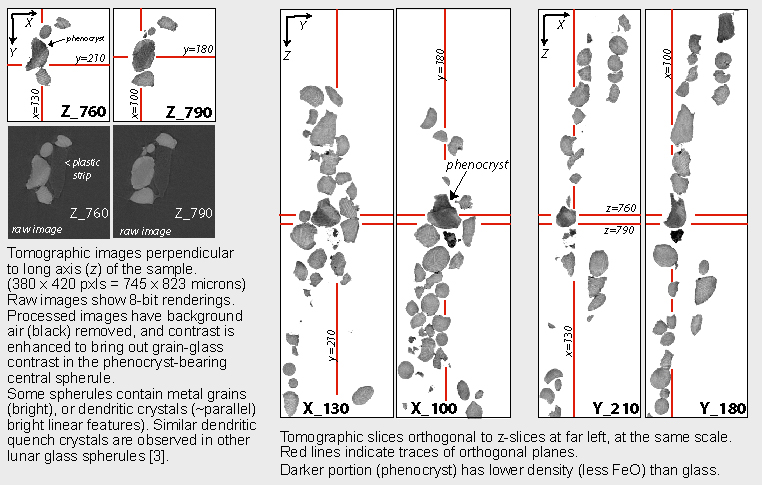
Results: Visual inspection of tiff format image stacks, and stacks made
into mpeg movies, revealed at least one olivine phenocryst in a single spherule.
This phenocryst-bearing spherule, and others in segment C of sample OG1, is
illustrated in Figs. 1a (close up), and 1b (the entire sample). Tomographic
slices in Fig. 1 are perpendicular to the z axis. Note the locations of x and y slices
shown in Fig. 2. Raw images show 8-bit renderings of the 16-bit data, in
cropped 380x420 pixel frames. Images above have intensities of x-ray attenuation
re-scaled to 4000-12000, from -7374 to 23809, with black (air) background made white.
The central spherule fragment contains a grain tentatively identified as
olivine ~MgSiO4 (spinel also occurs in spherules [8]), that is dark (lower attenuation)
relative to brighter, Ca-, Fe-bearing glass. This is the only unambiguous phenocryst
found to date. Other spherules contain metal grains, and some features may, in fact,
result from dendritic crystal growth in fast-cooling spherules. We also observed clasts
which are not spherical, and contain components with high (e.g., metal) and low
(e.g., voids) attenuation.
Discussion: The current work is preliminary in nature and aims to establish proof-of-concept.
This initial stage has concentrated on handling these rare spherules non-destructively,
and on locating spherules of interest after imaging. Although we did not definitively locate
any melt inclusions, the method gives a sense of the abundance of olivine phenocrysts in the
aliquot at hand. We have not yet segregated the phenocryst-containing spherule; however,
if it did contain melt, we should have been able to see it at 1.96 mm/pixel spatial resolution.
We have not yet mounted, cut and imaged sections of spherules. Some of the dendritic and barred
textures seen in images of the spherules may be quench textures, and they may allow constraints
to be placed on the cooling histories of these spherules.
Other methods of phenocryst identification could be pursued. For example we are exploring
use of a binary cut bulk x-ray diffraction method. A tube of spherules passing through an x-ray
beam will diffract strongly when phenocrysts occur. Successive halving of the olivine-bearing
aliquot can be used to isolate olivine-bearing spherules.
Conclusions: This non-destructive method has promise for identifying important
objects that should contain unique clues to the early magmatic history of the Moon.
Once phenocrysts with melt inclusions are identified, infrared spectroscopy can reveal
the original volatile contents that drove the fire-fountaining of the orange glass parent magmas.
This would yield the volatile composition of the ancient orange glass magma.
These downloads are provided as a public service for interested colleagues and web surfers.
Listing (linked) of files:
Whole volume OG1-section C (1.96 micron/pixel):
X-movie (8-bit mpg, 6.4MB total).
X-movie (8-bit mpg, 7.1MB total).
Z-movie (8-bit mpg, 25.6MB total).
Whole volume OG1-section D (1.96 micron/pixel):
Z-movie (8-bit mpg, 8.7MB total).
Acknowledgments
Use of the Advanced Photon Source was supported by the U.S. Department
of Energy, Office of Science, Office of Basic Energy Sciences, under Contract
No. W-31-109-ENG-38. Use of the GSE-CARS beamline, University of Chicago, is gratefully
acknowledged.
This work has been supported by the American Museum of Natural History.
Disclaimer:
This collection of pages describing the work of Denton Ebel and collaborators is provided by
Denton Ebel as a free public service. Denton Ebel, the Dept. of Earth and Planetary Sciences,
and all of their
parent organizations make no guarantees as to the accuracy, timeliness or availability of
this service or data provided by it.
We cannot be held responsible for any circumstances resulting from its use, inavailability, or
possible inaccuracy. We reserve the right to suspend or discontinue this service or portions
thereof at any time.
We also reserve the right to deny access to any individual or organization that we determine is
abusing this service. Be aware that if we are forced to terminate your access, all access from
your location may be terminated as a side effect, therefore preventing others at your location
from using our service. Examples of abuse include automated transfers resulting in excessive
data requests (because it hinders others from accessing the service) and attempting to gain
access to documents and host machines not intended for public use.
Last modified July 27, 2005.








